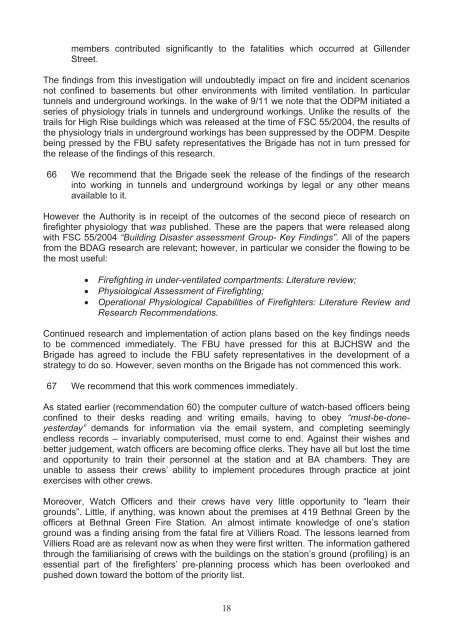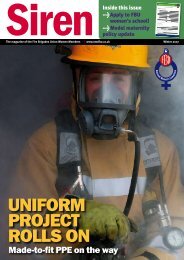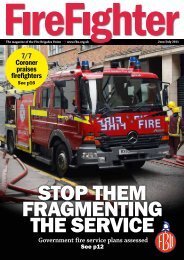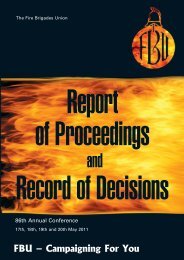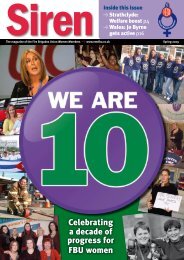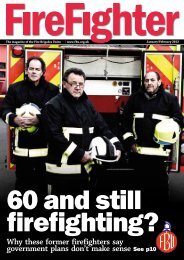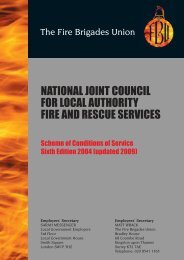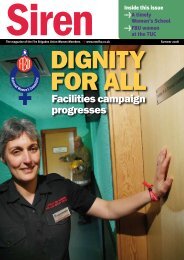FBU Bethnal Green - Fire Brigades Union
FBU Bethnal Green - Fire Brigades Union
FBU Bethnal Green - Fire Brigades Union
- No tags were found...
You also want an ePaper? Increase the reach of your titles
YUMPU automatically turns print PDFs into web optimized ePapers that Google loves.
members contributed significantly to the fatalities which occurred at GillenderStreet.The findings from this investigation will undoubtedly impact on fire and incident scenariosnot confined to basements but other environments with limited ventilation. In particulartunnels and underground workings. In the wake of 9/11 we note that the ODPM initiated aseries of physiology trials in tunnels and underground workings. Unlike the results of thetrails for High Rise buildings which was released at the time of FSC 55/2004, the results ofthe physiology trials in underground workings has been suppressed by the ODPM. Despitebeing pressed by the <strong>FBU</strong> safety representatives the Brigade has not in turn pressed forthe release of the findings of this research.66 We recommend that the Brigade seek the release of the findings of the researchinto working in tunnels and underground workings by legal or any other meansavailable to it.However the Authority is in receipt of the outcomes of the second piece of research onfirefighter physiology that was published. These are the papers that were released alongwith FSC 55/2004 “Building Disaster assessment Group- Key Findings”. All of the papersfrom the BDAG research are relevant; however, in particular we consider the flowing to bethe most useful:<strong>Fire</strong>fighting in under-ventilated compartments: Literature review;Physiological Assessment of <strong>Fire</strong>fighting;Operational Physiological Capabilities of <strong>Fire</strong>fighters: Literature Review andResearch Recommendations.Continued research and implementation of action plans based on the key findings needsto be commenced immediately. The <strong>FBU</strong> have pressed for this at BJCHSW and theBrigade has agreed to include the <strong>FBU</strong> safety representatives in the development of astrategy to do so. However, seven months on the Brigade has not commenced this work.67 We recommend that this work commences immediately.As stated earlier (recommendation 60) the computer culture of watch-based officers beingconfined to their desks reading and writing emails, having to obey “must-be-doneyesterday”demands for information via the email system, and completing seeminglyendless records – invariably computerised, must come to end. Against their wishes andbetter judgement, watch officers are becoming office clerks. They have all but lost the timeand opportunity to train their personnel at the station and at BA chambers. They areunable to assess their crews’ ability to implement procedures through practice at jointexercises with other crews.Moreover, Watch Officers and their crews have very little opportunity to “learn theirgrounds”. Little, if anything, was known about the premises at 419 <strong>Bethnal</strong> <strong>Green</strong> by theofficers at <strong>Bethnal</strong> <strong>Green</strong> <strong>Fire</strong> Station. An almost intimate knowledge of one’s stationground was a finding arising from the fatal fire at Villiers Road. The lessons learned fromVilliers Road are as relevant now as when they were first written. The information gatheredthrough the familiarising of crews with the buildings on the station’s ground (profiling) is anessential part of the firefighters’ pre-planning process which has been overlooked andpushed down toward the bottom of the priority list.18


